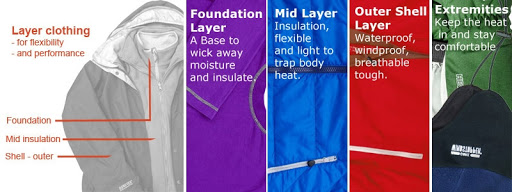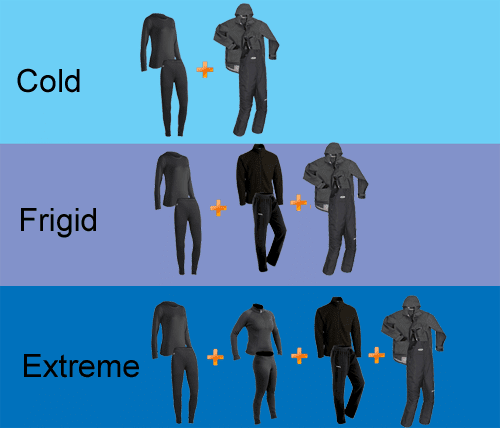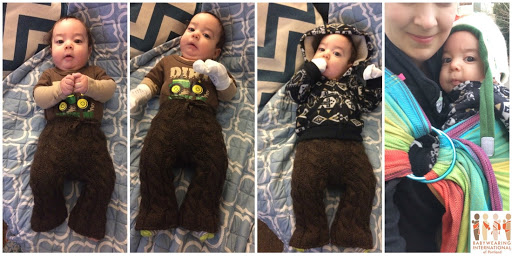How to Layer Yourself and Your Baby When Babywearing in the Cold
- Blog How to Layer Yourself and Your Baby When Babywearing in the Cold
Winter is upon us, and as much as this weather makes us want to hibernate and never leave the house again, at some point, we have to venture out in the cold. And that might mean bringing baby with us, too. Babywearing is a great way to keep babies safe, dry, and warm in winter weather. Here's everything you need to know about layering when babywearing in the cold.
Basics of Layering
The most important thing you need to do is to maintain a normal body temperature for both baby and you. For the same reason you must put your own oxygen mask on first in a plane emergency, you need to have all your faculties to properly care (or wear) a child. So take care of yourself and make sure you are bundled up before you get baby ready. In the winter, both the cold and sweat are your enemies.
Too cold and you risk health issues like hypothermia, frostbite, extreme dry eye pain, even trench foot. Too many layers can cause you or your baby to overheat, leading to sweating (your body’s natural cooling-off mechanism). Once the sweat touches the cold air, you'll begin to cool down even faster, speeding up the cold risks mentioned above. The key to keeping both you and baby warm is layering. Wearing layers help trap in heat, keep the sweat away, and can be removed/added as needed to keep you both at the optimal temperature. Here is a wonderful infographic from an Antarctic travel site. 
In a nutshell, you and baby need a base layer to keep you from sweating, an insulation layer to keep you warm, and a waterproof layer to keep you dry and cover all your extremities. The layers can vary depending on the weather outside. For example, a raincoat would be perfect for a typically cool, drizzly Portland winter day but not warm enough for snow at Timberline. Here is an infographic from an outdoor sports retailer on layering for different temperatures. 
Now that you get the basic layering idea, you may be wondering how to apply this to your baby. The most important thing to remember when wearing in the cold is that the carrier counts as a layer. And, if you are using a wrap, multiple pass carries count as multiple layers. You need to adjust your layering accordingly. Less clothing or a different carrier may be necessary to keep a normal body temperature.
For example, if it’s cool and rainy, a base layer, jacket, and a waterproof SSC is a good combination. If it’s snowing and windy, base, insulating, outer, hats/gloves and a thick woven wrap in a double hammock would be a great option. Below are some examples of layering for a baby in different winter weather types.
Cool
When it’s above freezing, but not warm by any means. Or maybe it is freezing, but you aren’t going to be outside long; for example, running into the store.
- First photo: Base layer of a thicker long sleeve onesie and thick pants. Wool pants are a great choice.
- Second photo: Add warm gloves and socks.
- Third photo: Warm, but not bulky coat. Fleece and wool work well. Add a hat if no hood.
- Fourth: Carrier, no need for multiple passes. For a quick babywearing up, try a ring sling if you're just taking your baby out of the car seat and into a store.
- Total: 2 clothing layers, plus extremities covered, and one carrier layer.
Cold
When it’s cold, closer to freezing, and no precipitation. Making sure extremities are well covered will keep baby warm.
- First photo: Base layer of wool socks and a long-sleeve onesie.
- Second photo: Warmer layer, I did overalls, but a shirt and pants would be great as well. Wool is a great fiber for this layer.
- Third photo: Leg warmers/more socks over feet and legs to keep ankles from being exposed.
- Fourth photo: Outer layer of a fleece one-piece suit. Make sure it is on the bigger side so it doesn’t pull on baby’s feet in the spread-squat position.
- Fifth photo: Carrier, with multiple passes, as needed for warmth.
- Total: 3 clothing layers, extremities covered, and 1-3 carrier layers.

Colder
When it very cold or just above freezing, layers under a snowsuit are a great option.
- First photo: Base layer of a thicker onesie.
- Second photo: Warm pants and a long-sleeve shirt. Wool is a great fiber for this layer!
- Third photo: Leggings or long socks and gloves.
- Fourth photo: Warm, waterproof one-piece suit. Hand and feet covers. Make sure it’s a little on the bigger side for baby to move freely in the spread-squat position.
- Fifth photo: Carrier with multiple passes.
- Total: 3 clothing layers, plus extremities covered, and 2-3 carrier layers.

Below freezing or snowing:
When it’s below freezing and/or snowing. An extra insulation layer keeps baby warmer and a waterproof layer keeps you dry.
- First photo: Base layer long shirt, long pants, and socks.
- Second photo: Thermal shirt, warm pants, and thick socks. Wool is a great fiber for this layer.
- Third photo: Wool or fleece jacket.
- Fourth photo: Waterproof jacket, hat, boots (or covered feet for non-walking child), and gloves. Waterproof pants are also a great addition if your child will be out of the carrier to walk.
- Fifth photo: Carrier that you don’t mind getting damp. A waterproof SSC is a great option, especially if your toddler might be getting out to walk occasionally. A woven wrap with multiple passes will add layers of warmth.
- Total: 4 layers of clothing, plus extremities covered, and 3 carrier layers.

Now that you've learned how to layer for the cold, stay warm and wear those babies!
Read more:
- Hard-framed carrier: improve the quality of your hike
- 5 Comfy and cozy winter carriers for babywearing
- How to carry supplies when hiking with a soft-structured carrier
ABOUT OUTGROWN
OutGrown is a 501(c)(3) nonprofit that works to create a world where everyone can enjoy the physical and mental benefits of spending time outside. We are focused on creating opportunities and removing barriers to access so families with babies and young children can take their first steps outside. We believe all families have the right to connect with nature, benefit from spending time outdoors and be inspired to a lifelong love of nature. Since its grassroots inception in 2013, OutGrown is a growing community of 280,000 families and over 300 volunteer Branch Ambassadors. More information on all of our programs can be found at WeAreOutGrown.org
EDITORS NOTE:
We hope you enjoyed reading this article from OutGrown. We’re working hard to provide our community with content and resources that inform, inspire, and entertain you.
But content is not free. It’s built on the hard work and dedication of writers, editors, and volunteers. We make an investment in developing premium content to make it easier for families with young children to connect with nature and each other. We do not ask this lightly, but if you can, please make a contribution and help us extend our reach.
Related Content





Comments